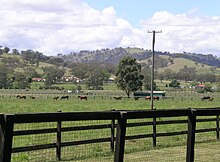Stud farm

Astud farmorstudinanimal husbandryis an establishment forselective breedingoflivestock.The word "stud"comes from the Old Englishstodmeaning "herd of horses, place where horses are kept for breeding".[1]Historically, documentation of the breedings that occur on a stud farm leads to the development of astud book.Male animals made available for breeding to outside female animals are said to be "standing at stud", or at "stud service", referencing the relatively high probability that they are kept at a stud farm.
The word stud is often restricted to larger domesticated (especially farm) animals, such ascattleandhorses.A specialized vocabulary exists for the studs of other animals, such askennel(dog),cattery(cat) andaviary(birds).
Horse stud farms[edit]
Monastic stud farms[edit]

During theMiddle Ages,stud farms were often managed as part of amonastery.At the time, few people apart from monks could read and write, and so they were charged with the responsibility of recordingpedigrees.TheCarthusianmonks are famous for their role in breeding theAndalusian horseinSpain,while monasteries inBavariawere responsible for the originalRottalerhorse. The oldest stud farm in Europe still in existence today is the Mews ofEinsiedeln Abbey(1064)[2]in Switzerland whereEinsiedlerhorses are bred.
State stud farms[edit]

A state stud farm (German:Landgestüt,French:Haras) is one owned by the government. The first state studs were ordered byLouis XIV of Francein 1665. The purpose of the state studs was to make high-quality horses available to local breeders and farmers to accelerate the evolution of local horses. Stud farms which kept a herd ofmaresin addition tostallionswere dubbed "Principal" Studs. State-owned stallions were made accessible with low or nostud fees.Germanyis most famous for its Principal and State Studs, which have been instrumental in the shaping of the German riding horses and several breeds of German cold bloods. TheHanoverianis associated with theState Stud of Celle,theRhinelanderandWestphalianwith the State Stud ofWarendorf,theBrandenburgerwith the Principal Stud of Neustadt an der Dosse, and so on.[3]
Other European state studs include:
- Haras national du Pin,the first state stud created inFrance
- Lipizza(1580) ofInner Austria(now Lipica,Slovenia), known for theLipizzanerhorse
- Kladrub (1579), another state stud established by Austria atKladruby nad Labem,in what is now the Czech Republic, which breeds theKladruber
- Mezőhegyes(1784) of Hungary
- Bábolna(1789) of Hungary, which breeds theArabian horse,theShagya Arabianand others
- Radautz(1792) of Austria (present dayRomania)
- Piber Federal Stud(1798) of Austria, began as a military depot, since 1920 known for breeding theLipizzanerhorse
- Janów Podlaski Stud Farm(1817) in Poland, best known for breeding purebredArabians.
- Kisbér(1853) of Hungary
- TheIrish National Stud(1946), which breedsThoroughbreds
- Michałów(1953) of Poland, which breeds Arabians.
- Marbach stud,(1477) also known as Weil-Marbach,Württemberg(present day Germany). Produces Arabians,Black Forest Horses,Haflingers,andwarmbloods
- Trakehnen,in East Prussia, now Russia, home of theTrakehner
- Yeguada Militar,Spain
- Coudelaria de Alter Real, in Central Portugal, which breeds Lusitano (Lusitano) Horses
The German city of "Stuttgart"gets its name from stud farms.
Private stud farms[edit]

Around the world, private individuals have breeding farms of various sizes that are dedicated to animal breeding, usually ofpurebredlivestock. Some may have originally been founded with government assistance or sponsorship, or owned by political leaders, while others are solely theprivate enterpriseof those who own them. Some of the largest and most impressive are those dedicated toThoroughbredhorse breeding, such as the historicClaiborne FarminKentuckyor theDarley Stud,owned by DubaiSheikh Mohammed bin Rashid Al Maktoum,which stands over fifty stallions at stud in facilities located in seven countries.
Stud service[edit]
Many stud farms make male animals available for breeding to outside female animals that are not owned by the stud farm. Doing so provides an outside source of revenue to a stud farm via thestud feespaid to obtain the services of the stud animal as well as contributing to the overallgenetic diversityof the animal's offspring. At state stud farms, stud service is not only a source of income, but due to the high standards set for breeding animals, has an overall effect of improving the quality of animals throughout an area.
In most cases, the owner of the female brings the animal to the stud farm for breeding, sometimes leaving her there for over a month to be sure that pregnancy has occurred. However, with the invention ofartificial inseminationand the ability to ship semen, combined with the availability ofDNAtesting for parentage verification, manybreed registriesallow semen to be shipped from the stud farm to the location of the female animal, thus reducing or eliminating the need for animals to travel.
Stud manager[edit]
A stud manager or "stud master" is an individual responsible for an employer'sbreedingstock. The term is usually used for individuals working withdogsorhorses.It is usually applied regardless of gender.
The stud manager typically suggests desiredmatingsto the owner, and arranges for the same, whether in-house or by contract with animals standing at stud, approves and arranges matings to the owner's animals at stud requested by outsiders, and keeps all records, including notifying the appropriate animalregistries.
In a Europeanlarge or formal householdthe "Stud Master" or manager may be a permanent title and position; in this case this individual is often responsible for overseeing the maintenance of thestablesandkennelsas well. Most large stud farms have a full-time individual assigned to stallion management, but many stud managers have either a part-time or contractual arrangement or their duties as stud manager may be incorporated with those of the overall farm or stable manager.
See also[edit]
References[edit]
- ^"Online Etymology Dictionary".Etymonline.Retrieved24 June2014.
- ^"Das Zentrum der Einsiedler Pferdezucht."Einsiedlerpferde.Retrieved 2021-10-09.
- ^Eylers."History and present day situation of the principal and state studs of Germany".State Studs of Germany.Archived fromthe originalon 3 February 2008.Retrieved5 February2008.
